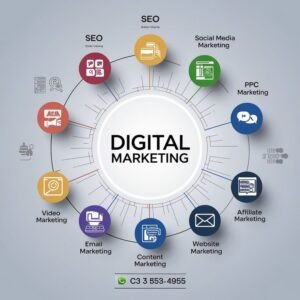What Is Digital Marketing?
Digital marketing encompasses all marketing activities that utilise digital platforms and technologies, often requiring an internet connection. This broad category includes online marketing, which specifically refers to marketing conducted via the Internet, such as email marketing, paid advertisements on social media platforms, and search engine optimisation (SEO).
Digital marketing techniques include a wide range of methods, such as marketing automation, email marketing campaigns, and social media strategies. These methods leverage digital channels to reach and engage audiences.
While “digital marketing” and “online marketing” are sometimes used interchangeably, it’s important to note their distinctions. Digital marketing refers to all marketing efforts that use digital channels, including online (internet-based) and offline (non-internet-based) methods, such as digital billboards, mobile SMS marketing, and on-demand television advertising. Online marketing, a subset of digital marketing, involves explicitly marketing activities on the internet. Despite the overlapping aspects, the current understanding categorises online marketing as a type of digital marketing focusing solely on internet-based activities.
The Benefits of Digital Marketing
Digital marketing is crucial for business growth in today’s technology-driven world. Consumers spend many hours every day online checking email, using social media, reading news, and shopping.
Digital marketing creates growth by allowing businesses to consistently contact customers and leverage digital data for personalised marketing efforts.
Using digital marketing can expand revenue potential and growth.
Unlike old-school tactics like billboards and radio ads, digital marketing helps organisations carefully target their ideal audiences, which results in a higher return on investment (ROI) than traditional, offline marketing methods.
In addition to reaching a targeted audience, there are other benefits of digital marketing, including:
- It’s cost-effective: Small and midsize businesses often struggle to compete with big brands. Digital marketing helps even the playing field. With a clear digital marketing strategy, even a small budget can help drive leads and customers to your website, app, or in-person store.
- It’s easy to measure: Some marketing campaigns generate decent ROI, but it’s hard to attribute a sale to a specific ad or see clear success metrics. Using an integrated digital marketing strategy, you can track users across the entire buying cycle to better understand what works — and what could be improved. In fact, 72% of high-performing marketing teams analyse performance in real-time.
- It drives engagement: With digital marketing, brands can interact with customers wherever they are in the customer journey. For example, you can educate, answer questions, and even provide customer service all from one platform.
- It’s personalised to customers: Digital marketing allows businesses to segment customers based on their interests and engagement history to create personalised experiences at scale. This allows businesses to impress customers at every step of their journey.
- It’s possible to update and optimise: You can’t make changes once a direct mailer is in transit or a billboard goes up. With digital marketing, brands can test different headlines, fix typos, and tweak ads with a few buttons, and changes appear immediately.
The Importance of Digital Marketing
It’s a big, complicated world in digital marketing these days, full of changing technologies, rising customer expectations, and omnipresent pressure to both grow and innovate. Consumers live online, and the battle for their attention–and their loyalty–has never been fiercer. 80% of marketers agree that customer experiences are the key differentiating factor, which puts tremendous pressure on marketing teams to deliver the best ones.
Where those experiences are happening has changed, too. Businesses used to exclusively reach customers through billboards, newspapers, magazines, radio, or television ads. Now, businesses can connect with the 92% of Americans using the internet through digital channels, including social media, news websites, mobile and email. Digital marketing also called online marketing, includes communication through text or multimedia messages and leverages digital channels such as search engines, social media, email, and other websites to connect with current and prospective customers.
Let’s break down the core tenets of implementing a digital marketing strategy the right way.
Digital Marketing Guide: Table of Contents
- Digital Marketing Defined
- Digital Marketing Benefits
- Types of Digital Marketing
- How to Create a Digital Marketing Strategy
- Digital Marketing Trends
What Are the Different Types of Digital Marketing?
You can use dozens of digital marketing channels to carry out your strategy, including social media sites, SMS, and more. The sheer number of options can be overwhelming.
Below are explanations of four basic types of digital marketing: social media marketing, search engine optimisation (SEO), pay-per-click (PPC), and email marketing. Remember, digital marketing is customisable and easy to change. If a strategy isn’t as successful as you’d like, rethink your plan, change platforms or tactics, and try something new.
Social Media Marketing
Social media marketing leverages platforms like Facebook, Twitter, LinkedIn, TikTok, and Instagram to build connections with potential customers and drive leads or sales. B2C digital marketing often leverages social media platforms like Instagram and Pinterest to attract customers directly to the website and guide them through an accelerated buyer’s journey.
There are two main types of social media marketing:
- Inbound social media: Posting educational information, sharing resources, using paid ads (such as those promoting a lead gen campaign), and even sharing funny memes, all of which help you build a relationship with your audience.
- Outbound social media: Commenting on other social media profiles or participating in hashtag conversations are modern takes on the classic “interruption” style of outbound marketing, which helps with brand awareness and brand building.
Nearly every type of business, from small e-commerce businesses to large enterprise organisations, can use social media to drive customer engagement, leads, and sales.
These are the main benefits of social media marketing:
- Detailed targeting: Most platforms allow marketing teams to target ideal customer profiles based on demographics, interests, location, and language. This prevents wasting ad spending to reach audiences not interested in your campaign.
- Build brand awareness and trust: Consumers don’t generally make a purchase the first time they hear about a brand. With social media, you can reach your audience multiple times as they move through the sales funnel.
- It’s affordable: Social media marketing can be done with little to no budget. While you have to pay for ads, brands can post and interact with consumers for free through brand accounts.
- Easy-to-monitor results: Social media platforms and third-party tools offer analytics and tracking dashboards so you can monitor results, track interactions, and better understand your audience.
Search Engine Optimisation (SEO)
Search engine optimisation is a digital marketing strategy to help a website appear in results when users look up a word or phrase in search engines like Google and Bing. SEO is effective and imperative for all organisations, including small local companies, online-only brands, and enterprises. Search engine marketing (SEM) involves purchasing ad space in search engines to showcase ads for products in search results, complementing SEO strategies.
Why does SEO matter? When consumers look for a solution to a challenge, whether that challenge is what to eat for dinner or which payment processor to use for their business, they head to a search engine. There, they’ll read reviews, ask technical questions, and perform other searches that tie into where they are in their customer journey.
Nearly 5.9 million Google searches occur every day. SEO helps your business show up when users search for related terms.
There are several types of SEO. These include:
- Local: A subsection of SEO that helps businesses, such as a family-owned restaurant, appear in local search results.
- Technical: Technical optimisation of websites to improve search engine crawlers’ ability to crawl and index web pages, often performed by a developer or professional SEO developer and can involve changes to the code for the site.
- On-page SEO: Optimisation techniques applied to pages on your website that are visible to viewers, such as adding internal links, optimising blog posts for SEO, or using key terms in title tags.
- Off-page SEO: Optimisation techniques from your website, such as building backlinks, using PR and news announcements, or using social media to drive SEO results.
Pay per Click (PPC)
PPC refers to using paid ads to reach a highly targeted audience. For example, you could create an ad campaign targeting potential customers who visit your favourite news site. You can also use Google Ads to target users who search for a specific term like “buy a new [brand name] laptop.” Digital ads, including PPC, digital display ads, and mobile marketing, are essential components of a comprehensive digital marketing strategy.
Unlike billboard or radio ads, where businesses pay upfront, with PPC you only pay if a user clicks on your ads. Some platforms do charge by impression or view, but that is rare.
Considering PPC? Here are four benefits to keep in mind:
- Track your traffic: Using Urchin Tracking Modules (UTM) parameters allows you to see where traffic from your ads goes — and how often they convert.
- Make changes quickly: Did you make a mistake or want to test a new marketing approach? With PPC, you can change and relaunch ads in minutes.
- Reach a targeted audience: With paid ad platforms like Google Ads and Bing, you can choose exactly who you want to reach based on your internal email address list, current customers, specific demographics, or onsite behaviour.
- Expand your reach: If you’re launching a new product or want to expand to a new market, PPC can help your business reach a wider audience.
Whether you want to launch a new brand or bring back past customers, PPC can help you reach your marketing goals. Learn more about Google Ads, Google‘s PPC platform, here.
Email Marketing
Email marketing, or campaigns for your business sent via email messages, is one of the most effective digital marketing strategies because nearly every consumer in the U.S., and most of the consumers in the world, have an email address. In 2022, email accounted for 80% of all outbound marketing messaging.
More benefits of email marketing include:
- Complete control: Unlike SEO or social media, where other companies (Google, Bing, Facebook, Twitter) control your connection and reach, email marketing lets you connect directly with consumers. You do have to optimise to ensure your email metrics stay healthy, and there are email marketing best practices to follow just for that reason.
- Audience segmentation and personalisation: Email marketing software makes sending different emails to different audiences or personalising marketing strategies to each subscriber possible.
- High ROI: Email marketing has a high ROI, making it one of the most cost-effective marketing strategies.
- AI-friendly: Email marketing is uniquely suited to benefit from AI technology, including predictive AI that optimises send times and generative AI to help personalise subject lines and content.
Additionally, email marketing can be used at each marketing funnel stage and continue after the purchase. For example, you can drive traffic to your blog, launch a new product, promote your Black Friday sale, remind users to complete a purchase after abandoning their cart and ask for reviews post-sale.
The first steps in email marketing are building an email list and finding the right email marketing platform. Then, follow these email marketing tips to build a successful email marketing campaign.

